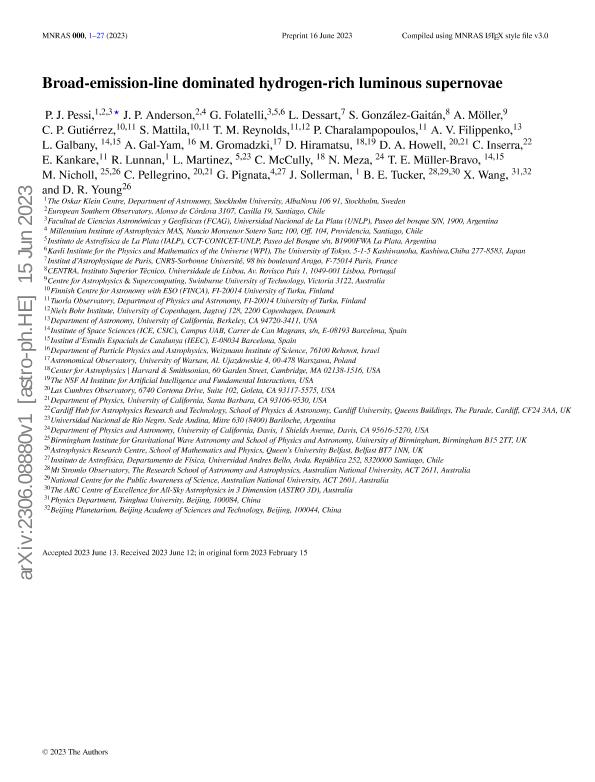Mostrar el registro sencillo del ítem
dc.contributor.author
Pessi, Priscila Jael

dc.contributor.author
Anderson, J. P.
dc.contributor.author
Folatelli, Gaston

dc.contributor.author
Dessart, L.
dc.contributor.author
González Gaitán, S.
dc.contributor.author
Möller, A.
dc.contributor.author
Gutiérrez, C. P.
dc.contributor.author
Mattila, S.
dc.contributor.author
Reynolds, T. M.
dc.contributor.author
Charalampopoulos, P.
dc.contributor.author
Filippenko, A.V.
dc.contributor.author
Galbany, Lluís

dc.contributor.author
Gal Yam, A.
dc.contributor.author
Gromadzki, M.
dc.contributor.author
Hiramatsu, D.
dc.contributor.author
Howell, D. A.
dc.contributor.author
Inserra, C.
dc.contributor.author
Kankare, E.
dc.contributor.author
Lunnan, R.
dc.contributor.author
Martinez, Laureano

dc.contributor.author
McCully, C.
dc.contributor.author
Meza, N.
dc.contributor.author
Müller Bravo, T. E.
dc.contributor.author
Nicholl, M.
dc.contributor.author
Pellegrino, C.
dc.contributor.author
Pignata, G.
dc.contributor.author
Sollerman, J.
dc.contributor.author
Tucker, B. E.
dc.contributor.author
Wang, X.
dc.contributor.author
Young, D. R.
dc.date.available
2024-04-29T14:33:05Z
dc.date.issued
2023-08
dc.identifier.citation
Pessi, Priscila Jael; Anderson, J. P.; Folatelli, Gaston; Dessart, L.; González Gaitán, S.; et al.; Broad-emission-line dominated hydrogen-rich luminous supernovae; Wiley Blackwell Publishing, Inc; Monthly Notices of the Royal Astronomical Society; 523; 4; 8-2023; 5315-5340
dc.identifier.issn
0035-8711
dc.identifier.uri
http://hdl.handle.net/11336/234197
dc.description.abstract
Hydrogen-rich Type II supernovae (SNe II) are the most frequently observed class of core-collapse SNe (CCSNe). However, most studies that analyse large samples of SNe II lack events with absolute peak magnitudes brighter than −18.5 mag at rest-frame optical wavelengths. Thanks to modern surveys, the detected number of such luminous SNe II (LSNe II) is growing. There exist several mechanisms that could produce luminous SNe II. The most popular propose either the presence of a central engine (a magnetar gradually spinning down or a black hole accreting fallback material) or the interaction of supernova ejecta with circumstellar material (CSM) that turns kinetic energy into radiation energy. In this work, we study the light curves and spectral series of a small sample of six LSNe II that show peculiarities in their H α profile, to attempt to understand the underlying powering mechanism. We favour an interaction scenario with CSM that is not dense enough to be optically thick to electron scattering on large scales – thus, no narrow emission lines are observed. This conclusion is based on the observed light curve (higher luminosity, fast decline, blue colours) and spectral features (lack of persistent narrow lines, broad H α emission, lack of H α absorption, weak, or non-existent metal lines) together with comparison to other luminous events available in the literature. We add to the growing evidence that transients powered by ejecta–CSM interaction do not necessarily display persistent narrow emission lines.
dc.format
application/pdf
dc.language.iso
eng
dc.publisher
Wiley Blackwell Publishing, Inc

dc.rights
info:eu-repo/semantics/openAccess
dc.rights.uri
https://creativecommons.org/licenses/by-nc-sa/2.5/ar/
dc.subject
SN 2017GPP
dc.subject
SN 2017HBJ
dc.subject
SN 2017HXZ
dc.subject
SN 2018AQL
dc.subject
SN 2018EPH)
dc.subject
TRANSIENTS: SUPERNOVAE – SUPERNOVAE: INDIVIDUAL (SN 2017CFO
dc.subject.classification
Astronomía

dc.subject.classification
Ciencias Físicas

dc.subject.classification
CIENCIAS NATURALES Y EXACTAS

dc.title
Broad-emission-line dominated hydrogen-rich luminous supernovae
dc.type
info:eu-repo/semantics/article
dc.type
info:ar-repo/semantics/artículo
dc.type
info:eu-repo/semantics/publishedVersion
dc.date.updated
2024-02-22T13:34:57Z
dc.journal.volume
523
dc.journal.number
4
dc.journal.pagination
5315-5340
dc.journal.pais
Reino Unido

dc.description.fil
Fil: Pessi, Priscila Jael. Universidad Nacional de La Plata; Argentina. European Southern Observatory Chile; Chile
dc.description.fil
Fil: Anderson, J. P.. Instituto Milenio de Astrofísica; Chile. European Southern Observatory Chile; Chile
dc.description.fil
Fil: Folatelli, Gaston. Consejo Nacional de Investigaciones Científicas y Técnicas. Centro Científico Tecnológico Conicet - La Plata. Instituto de Astrofísica La Plata. Universidad Nacional de La Plata. Facultad de Ciencias Astronómicas y Geofísicas. Instituto de Astrofísica La Plata; Argentina
dc.description.fil
Fil: Dessart, L.. Institut D'astrophysique de Paris; Francia
dc.description.fil
Fil: González Gaitán, S.. Instituto Superior Tecnico; Portugal
dc.description.fil
Fil: Möller, A.. Swinburne University Of Technology; Australia
dc.description.fil
Fil: Gutiérrez, C. P.. University of Turku; Finlandia
dc.description.fil
Fil: Mattila, S.. University of Turku; Finlandia
dc.description.fil
Fil: Reynolds, T. M.. University of Turku; Finlandia
dc.description.fil
Fil: Charalampopoulos, P.. University of Turku; Finlandia
dc.description.fil
Fil: Filippenko, A.V.. University of California at Berkeley; Estados Unidos
dc.description.fil
Fil: Galbany, Lluís. Instituto de Ciencias del Espacio; España
dc.description.fil
Fil: Gal Yam, A.. Weizmann Institute Of Science Israel; Israel
dc.description.fil
Fil: Gromadzki, M.. University of Warsaw; Polonia
dc.description.fil
Fil: Hiramatsu, D.. Harvard-Smithsonian Center for Astrophysics; Estados Unidos
dc.description.fil
Fil: Howell, D. A.. University of California; Estados Unidos
dc.description.fil
Fil: Inserra, C.. Cardiff University; Reino Unido
dc.description.fil
Fil: Kankare, E.. University of Turku; Finlandia
dc.description.fil
Fil: Lunnan, R.. Stockholm Universit; Suecia
dc.description.fil
Fil: Martinez, Laureano. Universidad Nacional de Río Negro. Sede Andina; Argentina. Consejo Nacional de Investigaciones Científicas y Técnicas. Centro Científico Tecnológico Conicet - La Plata. Instituto de Astrofísica La Plata. Universidad Nacional de La Plata. Facultad de Ciencias Astronómicas y Geofísicas. Instituto de Astrofísica La Plata; Argentina
dc.description.fil
Fil: McCully, C.. Harvard-Smithsonian Center for Astrophysics; Estados Unidos
dc.description.fil
Fil: Meza, N.. University of California at Davis; Estados Unidos
dc.description.fil
Fil: Müller Bravo, T. E.. Instituto de Ciencias del Espacio; España
dc.description.fil
Fil: Nicholl, M.. The Queens University of Belfast; Irlanda
dc.description.fil
Fil: Pellegrino, C.. University of California; Estados Unidos
dc.description.fil
Fil: Pignata, G.. Universidad Andrés Bello; Chile
dc.description.fil
Fil: Sollerman, J.. Stockholm University; Suecia
dc.description.fil
Fil: Tucker, B. E.. Australian National University; Australia
dc.description.fil
Fil: Wang, X.. Beijing Academy of Science and Technology; China
dc.description.fil
Fil: Young, D. R.. The Queens University of Belfast; Irlanda
dc.journal.title
Monthly Notices of the Royal Astronomical Society

dc.relation.alternativeid
info:eu-repo/semantics/altIdentifier/doi/http://dx.doi.org/10.1093/mnras/stad1822
dc.relation.alternativeid
info:eu-repo/semantics/altIdentifier/url/https://academic.oup.com/mnras/article/523/4/5315/7199790
Archivos asociados
